
Ink wash painting ; is a type of Chinese ink brush painting which uses washes of black ink, such as that used in East Asian calligraphy, in different concentrations. It emerged during the Tang dynasty of China (618–907), and overturned earlier, more realistic techniques. It is typically monochrome, using only shades of black, with a great emphasis on virtuoso brushwork and conveying the perceived "spirit" or "essence" of a subject over direct imitation. Ink wash painting flourished from the Song dynasty in China (960–1279) onwards, as well as in Japan after it was introduced by Zen Buddhist monks in the 14th century. Some Western scholars divide Chinese painting into three periods: times of representation, times of expression, and historical Oriental art. Chinese scholars have their own views which may be different; they believe that contemporary Chinese ink wash paintings are the pluralistic continuation of multiple historical traditions.
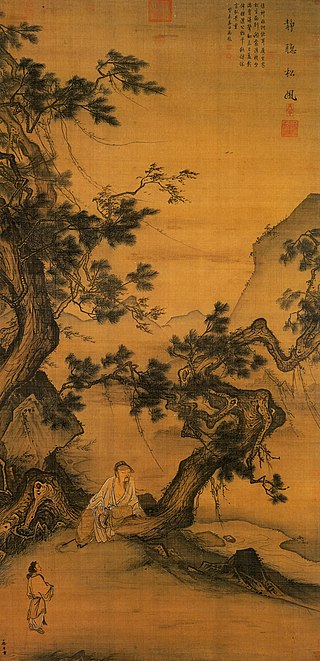
Chinese painting is one of the oldest continuous artistic traditions in the world. Painting in the traditional style is known today in Chinese as guó huà, meaning "national painting" or "native painting", as opposed to Western styles of art which became popular in China in the 20th century. It is also called danqing. Traditional painting involves essentially the same techniques as calligraphy and is done with a brush dipped in black ink or coloured pigments; oils are not used. As with calligraphy, the most popular materials on which paintings are made are paper and silk. The finished work can be mounted on scrolls, such as hanging scrolls or handscrolls. Traditional painting can also be done on album sheets, walls, lacquerware, folding screens, and other media.

Zhao Mengfu, was a Chinese calligrapher, painter, and scholar during the Yuan dynasty. He was a descendant of the Song dynasty's imperial family through Emperor Xiaozong's brother Zhao Bogui who married a lady surnamed Song who was the granddaughter of Emperor Huizong. Zhao Bogui was a descendant of Emperor Taizu, through his son Zhao Defang.
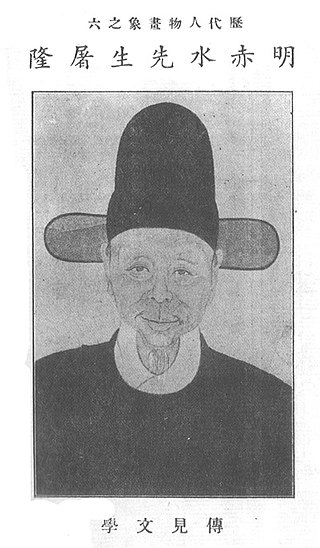
Tu Long, was a playwright and essayist who lived during the Ming Dynasty. He was born in Yin county.
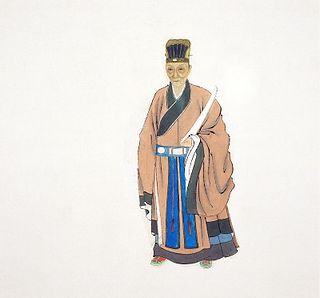
Dong Qichang, was a Chinese art theorist, calligrapher, painter, and politician of the later period of the Ming dynasty.

Wu Changshuo, born Wu Junqing, was a Chinese calligrapher, painter, and seal artist of the late Qing Period.

Fu Baoshi, or Fu Pao-Shih, was a Chinese painter from Xinyu, Jiangxi Province. He went to Japan to study the History of Oriental Art in the Tokyo School of Fine Arts in 1933. He translated many books from Japanese and carried out his own research. In painting itself, he brought Japanese visual elements to the Chinese ink painting tradition.
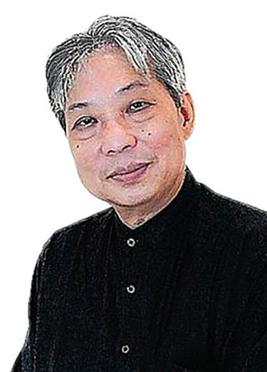
Chua Ek Kay was a Singaporean artist hailed as the "bridge between Asian and Western art" with a unique painting style using Chinese ink on paper that demonstrated an ingenious blend of traditional Chinese painting forms with Western art theories and techniques. Most of his works were themed of Chinatown street scenes, lotuses, and abstract works inspired by Australian aboriginal cave paintings.
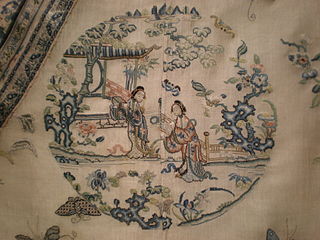
Chinese embroidery refers to embroidery created by any of the cultures located in the area that makes up modern China. It is some of the oldest extant needlework. The four major regional styles of Chinese embroidery are Suzhou embroidery, Hunan embroidery, Guangdong embroidery and Sichuan embroidery. All of them are nominated as Chinese Intangible Cultural Heritage.
Shang Yang is a contemporary Chinese painter based in Beijing and is considered one of the most important painters of the life-stream movement. Known for his oriental humanist thought he believes landscapes are living things and puts their spirit into his brushwork. In 1965 he graduated from the Hubei Art Academy, where he then taught for several years. He received his masters from the Hubei Art Academy in 1981. Yang became the Associate President in 1989. Shang Yang became a Professor and the Officer-in-Charge of Fine Arts at the Research Institute of South China Normal University in 1993. Also in 1993, he became the Vice President of the Chinese Art painting Society. Shang Yang has exhibited extensively in China since the 1980s, including at Shanghai Biennale in 1996, and has shown internationally at galleries in London, Paris, Tokyo, St. Petersburg, and Helsinki. Shang Yang's work often appropriates images from traditional Chinese landscape painting, which are screened onto the canvas by a machine; he then distorts the image with graffiti or obtrusive geometrical designs. His works combine avant-garde exploration and solid artistic skill to create unique works of expressionism oil painting.
The Xiling Seal Art Society is a Chinese arts organisation based in Hangzhou, Zhejiang Province, PRC. It was founded in 1904 but, with antecedents dating back to the Ming and Qing dynasties, is one of China's most important traditional stone seal engraving associations.
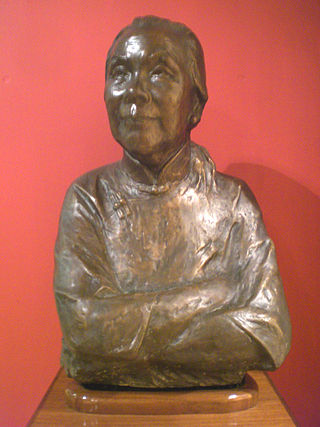
Fang Zhaoling, also known as Lydia Fong, was a Chinese painter and calligrapher.
Jennifer Oakes is an American poet, novelist, and teacher.
Zheng Lianjie is a Chinese contemporary artist, active in performance art, installation, photography, contemporary ink and video art. Zheng Lianjie is a representative figure in Chinese contemporary art. He is part of a generation of artists who grew up in China during the Cultural Revolution and in the 1980s turned from traditional forms of painting to installation art and performance-based work
Neil Meitzler (1930–2009) was an American painter, well known in the Pacific Northwest for his landscapes and scenes of nature, rendered in a distinctive, modern style. He is often associated with the 'Northwest School' art movement.
Jung Ying Tsao was a connoisseur, collector, dealer, and scholar of traditional Chinese art.
Yu Hong is a Chinese contemporary artist. Her works characteristically portray the female perspectives in all stages of life and the relationship between the individual and the rapid social changes taking place in China. She works primarily in oil paint but also in pastels, fabric dye on canvas, silk and resin. Yu Hong is "routinely named amongst China’s leading female artists". Her work is celebrated for its intimacy, honesty and tactility.

"Night-Shining White" is a monochrome ink-on-paper painting by the Chinese artist Han Gan. It is an example of Tang dynasty painting, created in the middle of the 8th century. The work depicts a cavalry horse owned by the Emperor Xuanzong of the Tang dynasty, tethered to a post. It is considered one of the greatest equine portraits in Chinese painting. It was acquired by the Metropolitan Museum in 1977.

Wang Huangsheng is a Chinese-born curator, educator and artist who is currently residing in Beijing. He used to serve as the director of China Central Academy of Fine Arts Museum for eight years. As an curator, he is most known for his curated events. He has been the curator of Guangdong Museum of Art and the Museum Art of Central Academy of Fine Arts for a long time.
Li Huayi is a contemporary ink artist whose admiration for the monumental landscapes of the Northern Song dynasty with his training in both traditional Chinese ink and Western art, inspired him to create his own style of ink painting.











